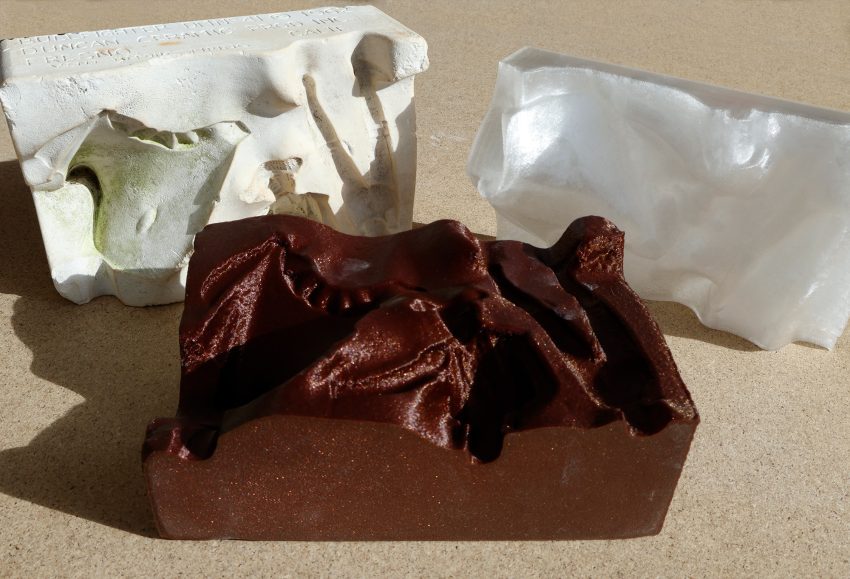My master’s degree studies in art education are primarily guided by the question: How can we teach empathy through artmaking?
So far, I’ve not found a formula for answering this question, but rather an ongoing practice of exposing students to a foundation of cultural and material histories, and modeling patience and empathy towards them. I emphasize collaboration among artist-learners while teaching methods of visual storytelling and the history of materials, which enables students to connect and share their outside knowledge through narrative inquiry. These approaches can help weave together paths and perspectives that might otherwise not meet, and can be applied to any art medium.
As a student of art education and a graduate extern at the Loretta Duckworth Makerspace, I am interested in developing a pedagogical strategy that will be useful to art educators across the country who seek to integrate digital methods into their classrooms, with a focus on sculpture and 3D design. I am particularly interested in reintroducing empathetic focus in digital 3D design.
The Need for Digital 3D Tools in Secondary Art Classrooms
While 2D drawing, painting, collage, and digital tools like Photoshop are standard in middle and high school art curricula, instruction in 3D artmaking is often treated as an elective or omitted entirely—even though three-dimensional design increasingly defines contemporary artistic practice, and many students naturally prefer to work this way. Research indicates that, despite the growing accessibility of digital fabrication tools, their integration into art classrooms remains limited.
I am especially interested in the generative tension between digital and physical environments. As students copy images from video games and online media, bridging screen-based work with hands-on making offers a way to re-engage their creativity while incorporating their contemporary interests. This dialogue between technology and materiality helps students consider how digital design connects to tactile experiences and the physical world, and positions technology as a partner in crafting rather than a replacement. While digital tools will inevitably change, the pedagogical framework of using material-digital exchange as a learning process can remain consistent.
3D Scanning as an Entry Point for Critical Making
3D scanning, also known as photogrammetry, captures an object’s surface from multiple angles to create a digital mesh. The resulting model can be textured with color and surface data, preserving fine details but often flattening texture and context, a phenomenon that has been described as the sterility of digitization, basically a version of the uncanny valley for non-humanlike objects. The sterility of the digital model, coupled with the isolation of digital design work, is where we can lose touch with empathy.

For students, this tension between digital and physical representation becomes an entry point into critical making. They must consider what the scan reveals and what it erases. Even the most precise digital model is not preservation but a digital surrogate.
To explore this concept, I plan to design a pedagogical exercise where students create museum-style labels, 3D print objects, arrange still lifes, and form molds to fill with materials such as paper pulp or plaster. Students will intentionally alter and remix their scanned forms, trade objects with peers, and observe how meaning shifts with each change in material and context. This is intended to prompt critical discussion about personal histories and how they might be represented through everyday objects, as well as to serve as an accessible introduction to 3D design tools.
3D Scanning Tools in the Secondary Classroom vs. Makerspace
For this project, I primarily use the Revopoint POP2 scanner with RevoScan software, a portable scanner that produces quick results with moderate resolution. To compare quality, I also use a Canon EOS R50 camera with Metashape. This free photogrammetry software stitches photographs into 3D models but requires a high-powered GPU to process detailed meshes.

These tools allow me to test workflows, but both the POP2 and GPU required for Metashape may be out of budget for most secondary schools; therefore, sourcing older models or alternatives will be crucial to the project.
This setup demonstrates the level of precision currently possible in university makerspaces. My next step is to test various 3D printers, evaluate their ease of use and cost, and compile a materials list for implementing a comprehensive critical making unit that utilizes 3D scanning and printing.
Goals and Next Steps
I am proposing an art teaching practice that enables student artists to alternate between physical, digital, and social learning experiences. By moving between these modes, students engage in critical thinking and creativity while collaborating with peers. Mixed-method learning exposes what materials can and cannot communicate, prompting reflection on presence, loss, and reinterpretation.
This year, I will explore this process with a cohort of graduate students and faculty by producing a sample collection of artworks, gathering survey responses, hosting workshops, and developing a unit plan that models how empathy practices can be emphasized in a digital fabrication curriculum. Ultimately, my goal is to document empathetic teaching practices and share them with educators as I learn and teach in the makerspace, aiming to cultivate better artistic skills, empathy, and attentiveness that sustain meaningful learning communities.
References
Anđić, B., Šorgo, A., Weinhandl, R., Maričić, M., & Lavicza, Z. (2024). Unveiling Hype Cycle patterns: Examining 3D modeling and printing adoption among secondary school teachers. TechTrends : For Leaders in Education & Training. doi:10.1007/s11528-024-01009-1
Black, J., & Browning, K. (2011). Creativity in Digital Art Education Teaching Practices. Art Education, 64(5), 19–34. https://doi.org/10.1080/00043125.2011.11519140
McDrury, J., & Alterio, M. (2003). Learning through storytelling in higher education: Using reflection and experience to improve learning. Routledge.
Meeken, L. A., & Knochel, A. D. (2022). Glitching Form: Subverting Digital Systems That Capture the Physical World. Art Education, 75(4), 49–56. https://doi.org/10.1080/00043125.2022.2053478
Nikonova, A., & Biryukova, M. (2017). The role of digital technologies in the preservation of cultural heritage. Muzeológia a Kultúrne Dedičstvo, 5, 169–173.
